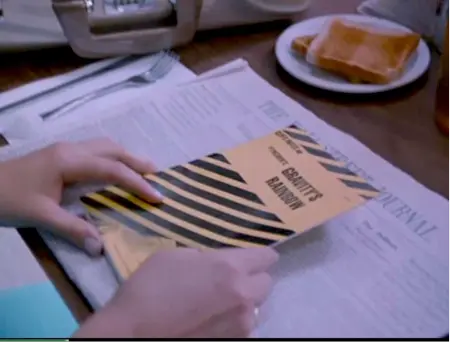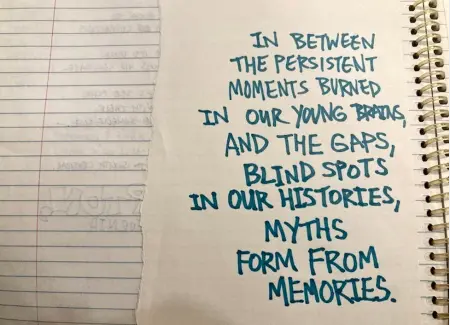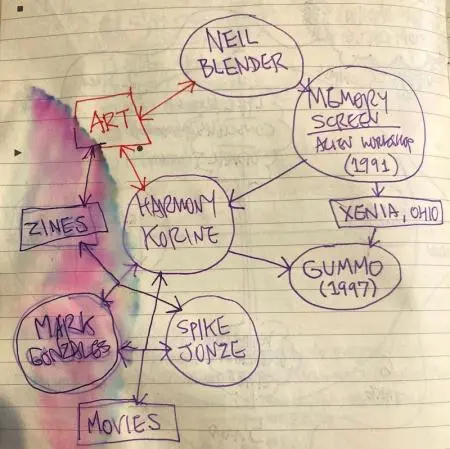A few years ago, as I was on a Blue Line train on my way to the loop in Chicago, I was reading Tade Thompson’s Rosewater (Apex, 2016) and listening to Hole’s Celebrity Skin (DGC, 1998). At the exact moment that I read the phrase “all dressed in white” on page 57 of Rosewater, Courtney Love sang the same phrase in my ears on the song “Use Once & Destroy.”
A few months later, I was clearing some records off my iPod to add a few new things, including the newly released Jay-Z record, 4:44 (Roc Nation, 2017). When I finally stopped deleting files and checked the available space, it was 444 MB. Just minutes later, while reading the latest Thrasher Magazine (July 2017), I happened to notice the issue number: 444.
Yesterday, I was browsing the clearance racks at Hot Topic (closely guarded fashion secret) as “MakeDamnSure” by Taking Back Sunday was playing. Just as Adam Lazzara sang “You are… you are so cool,” I slid a True Romance shirt into view that read “You are so cool” on the front.

Cliff’s Notes to Thomas Pynchon’s Gravity’s Rainbow in Miracle Mile (1988).
I watched Steve De Jarnatt’s Miracle Mile (1988) the other night. I found this movie in quite a roundabout way. A few years ago, William Gibson posted a picture of the Cliff’s Notes for Gravity’s Rainbow with the caption “The Key.” This sent me on a search. I dug in thrift stores, looked in bookstores, asked proprietors. No one seemed to know whether these particular Notes existed.
A couple of years later, I found out that the Cliff’s Notes to Pynchon’s most famous and confounding work were a prop for De Jarnatt’s 1988 apocalyptic love story, Miracle Mile (Gibson also mentions it in his 1993 novel Virtual Light, which I recently reread). The movie is wild, overdone in some ways and underdone in others. It reminded me of two of my other all-time favorites, Alex Cox’s Repo Man (1984) and Richard Kelly’s Southland Tales (2006), though it’s not as intentionally campy as the former and perhaps not as fully realized as the latter.
Sometimes things just sync up with no meaning outside of themselves. Sometimes there’s no alignment evident whatsoever, like how I came to Miracle Mile. Other times the path is important.

…myths form from memories.
Sometimes I get a book in the mail or from the library, and I can’t remember how I found it. In late 2000, during an especially impoverished period of my adult life, I was going to the Seattle Public Library almost every day. I was reading bits and pieces of so many books. I remember digging deeper into the work of Marshall McLuhan and Walter Benjamin, finding more Rebecca Solnit and Guy Debord, discovering Paul Virilio and Jean Baudrillard. I remember the row of volumes I had lined up against the wall in an almost completely unfurnished apartment, their spines and call numbers pointed at the ceiling. Due dates, new discoveries, and new arrivals kept the books rotating, and at some point, I started having a difficult time keeping up with where I'd read what. So, I started keeping a research journal.
While those journals — I’ve been keeping them ever since — help me remember things I’ve read, they’re less helpful in tracing my path to the things I read.

Skateboarding/zine-making/movie flowchart, December 8, 2019.
I do sometimes try to keep up with the paths with flowcharts like the one above. It’s not a new idea. Early versions include Paul Otlet’s 1934 Traité de Documentation and Vannevar Bush’s memex from the 1940s. The memex — a portmanteau of memory and expansion — was a dream machine for navigating and researching with the vast stores of information of the time using cameras, microfilm, and print — an analog hypertext system. In his 1945 article “As We May Think,” Bush wrote, “Wholly new forms of encyclopedias will appear, ready-made with a mesh of associative trails running through them, ready to be dropped into the memex and there amplified.”[1] The problem with the way that Bush proposes such “associative trails” is that they are of little use to anyone aside from the researcher who’s trod them. I mean, do you find the above flowchart useful without some narrative context? As Donald Norman puts it:
Following the trails of other researchers sounds like a wonderful idea, but I am not convinced it has much value. Would it truly simplify our work, or would all the false trails and restarts simply complicate our lives? How would we know which paths would be valuable for our purposes? [...] If you, the reader, were to follow these trails, you might not be enlightened.[2]
Maybe the mystery is better. I have so many precious books and movies and ideas that lack provenance or lineage. Does it matter? A meandering or aligned path doesn’t change the end result.
You can plan not synchronicity nor serendipity, but magic happens every day.
[1] Vannevar Bush, “As We May Think,” The Atlantic Monthly, July 1945, 176 (1): 101–108.
[2] Donald A. Norman, Living with Complexity, Cambridge, MA: The MIT Press, 2011, 134-135.
Get Rosewater at Bookshop or Amazon
Get Gravity's Rainbow at Bookshop or Amazon

About the author
Roy Christopher is an aging BMX and skateboarding zine kid. That’s where he learned to turn events and interviews into pages with staples. He has since written about music, media, and culture for everything from books and blogs to national magazines and academic journals. His books include Dead Precedents (Repeater, 2019), Boogie Down Predictions(Strange Attractor, 2022), and Escape Philosophy (punctum, 2022), among others. He holds a Ph.D. in Communication Studies from the University of Texas at Austin. As a child, he solved the Rubik’s Cube competitively.







